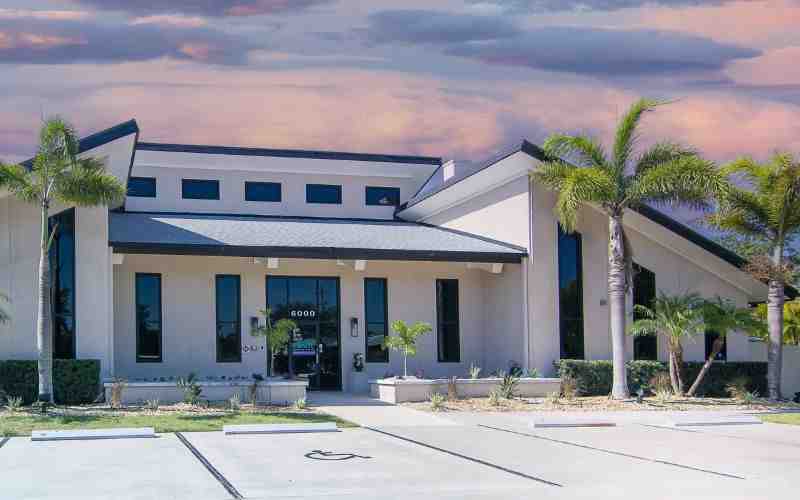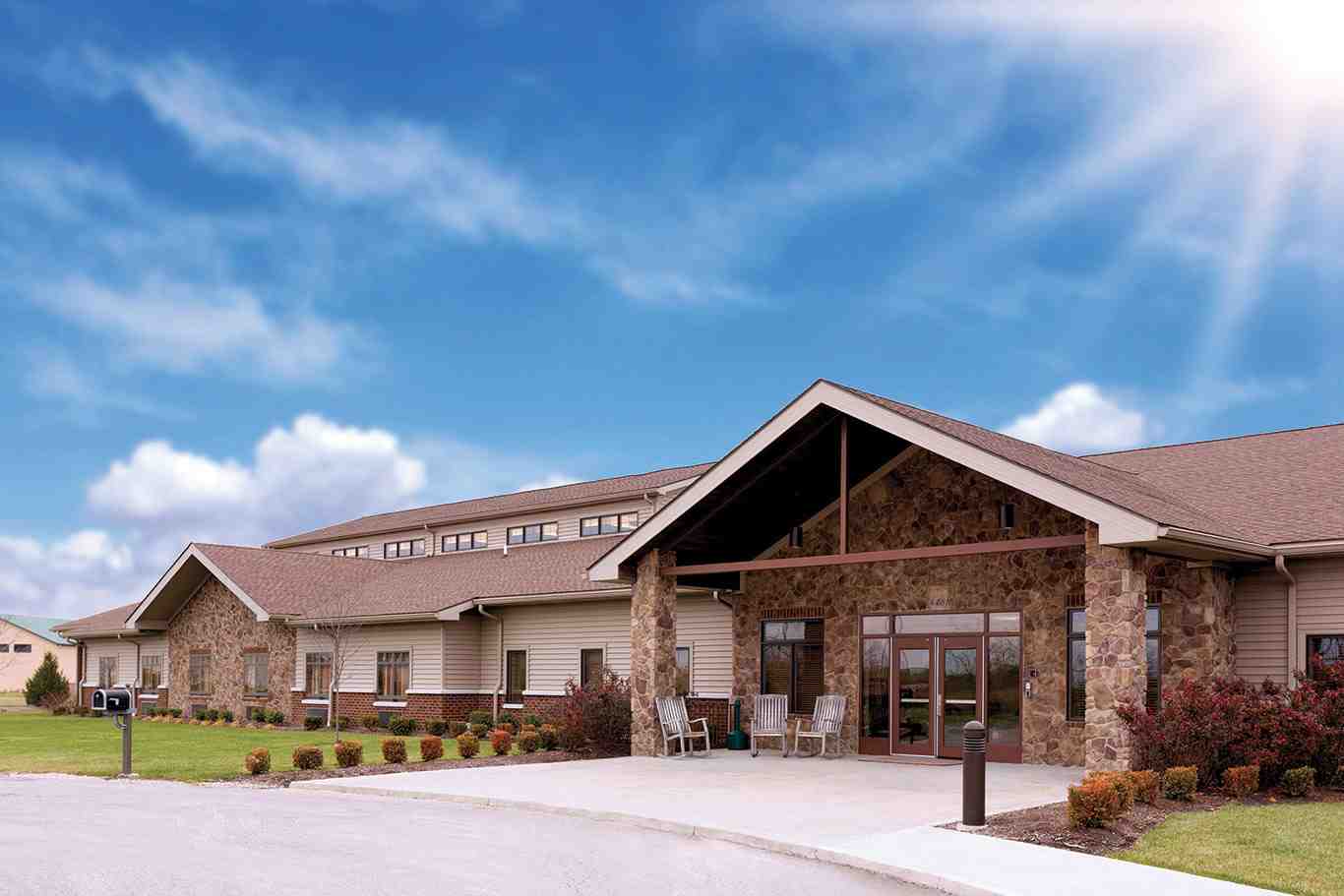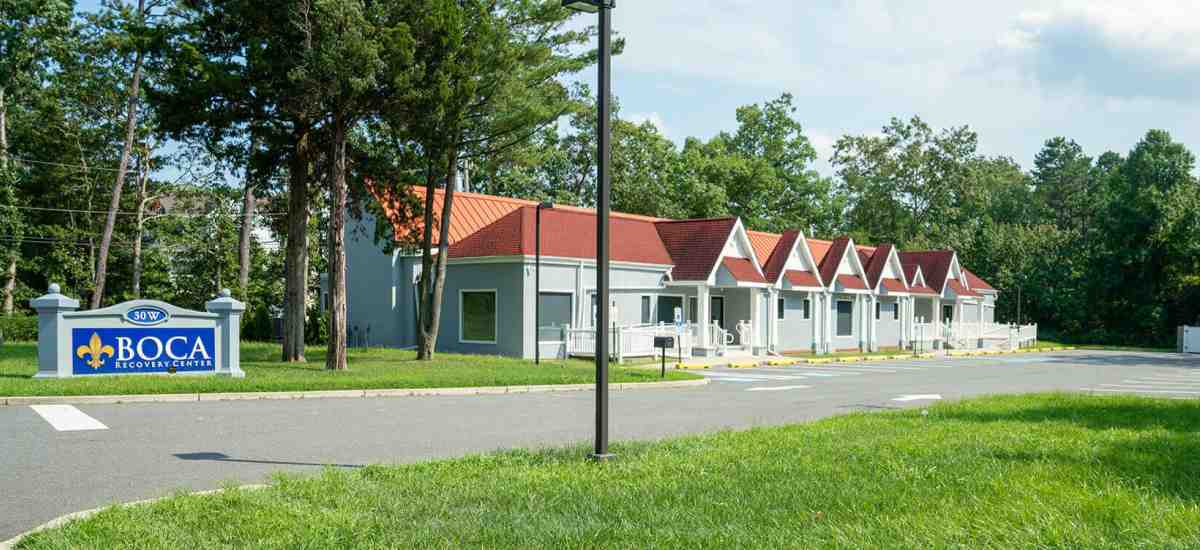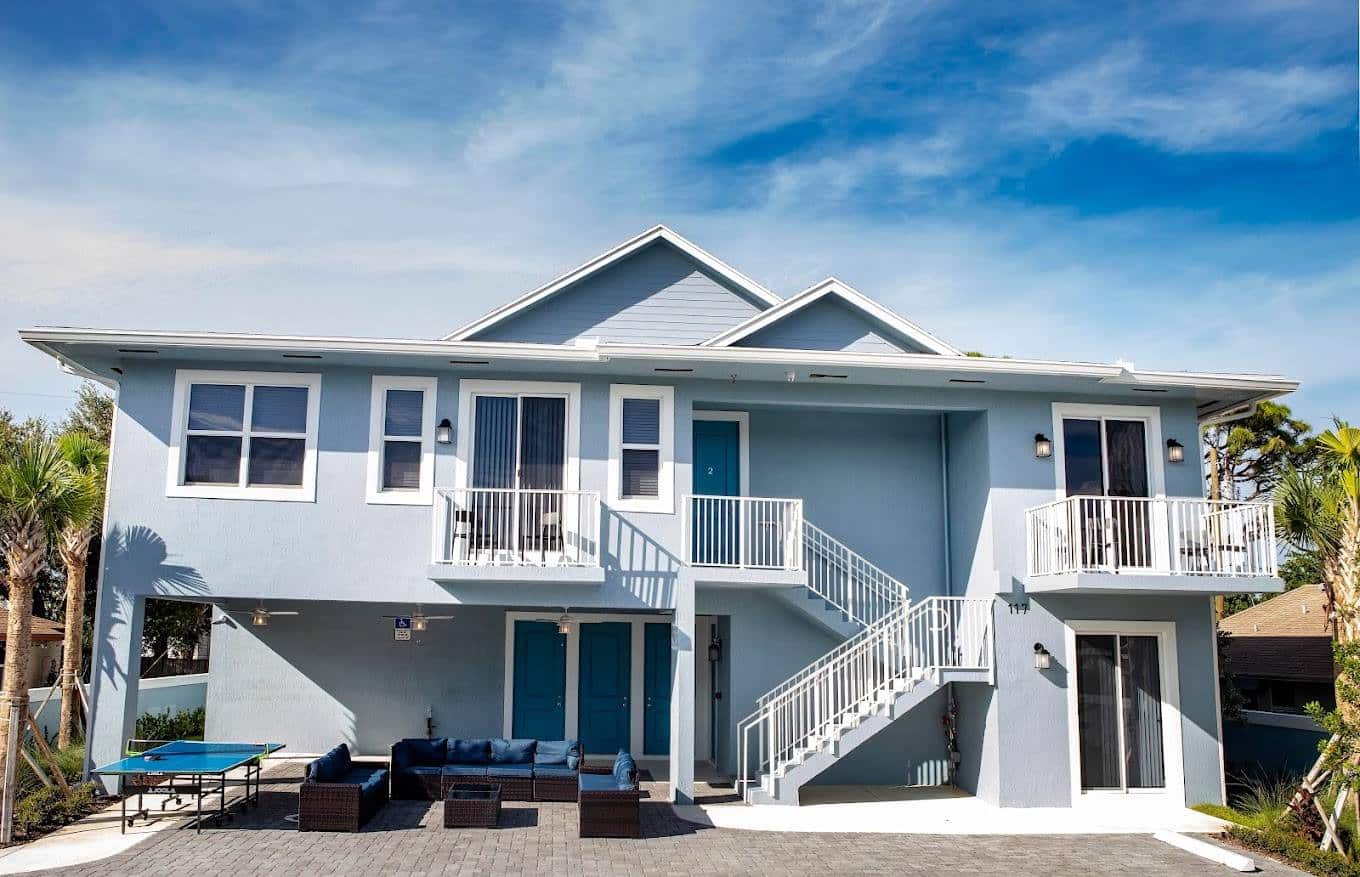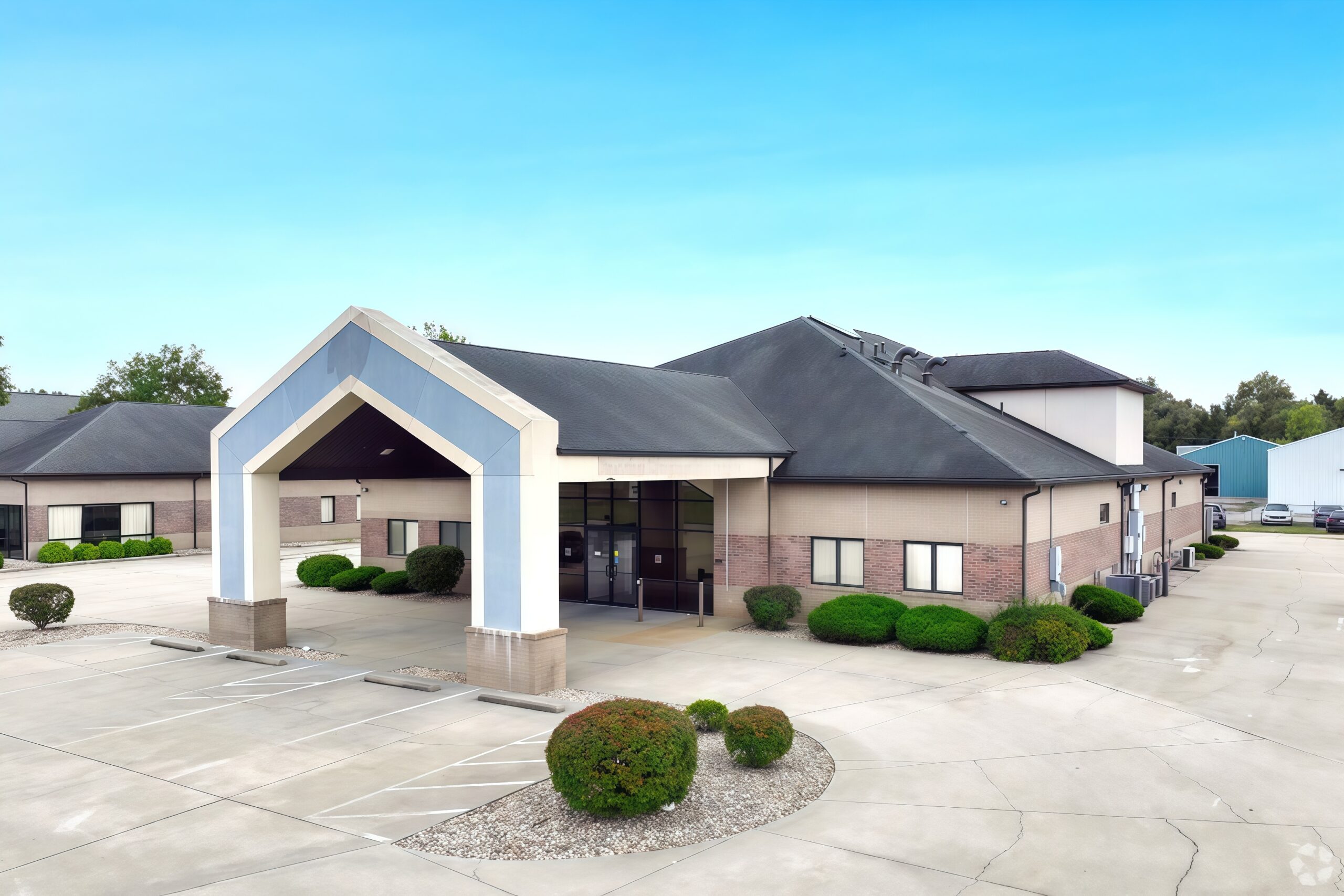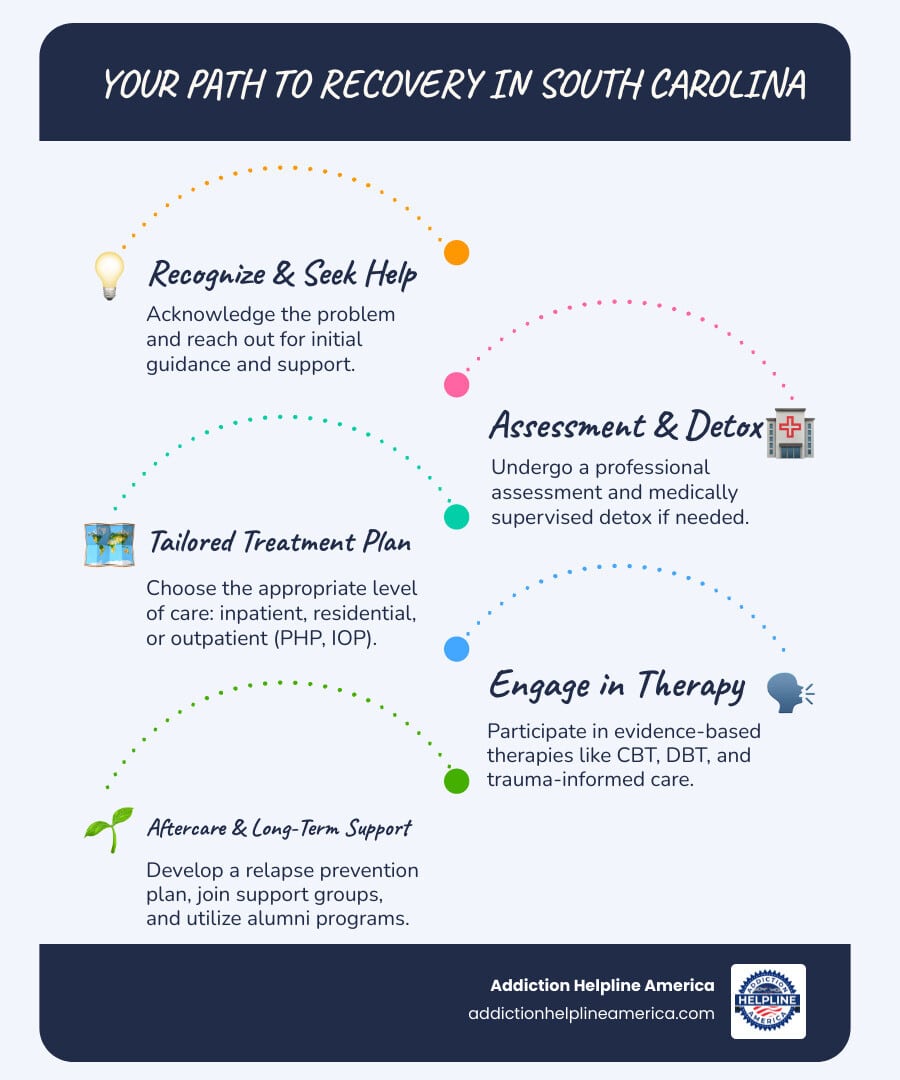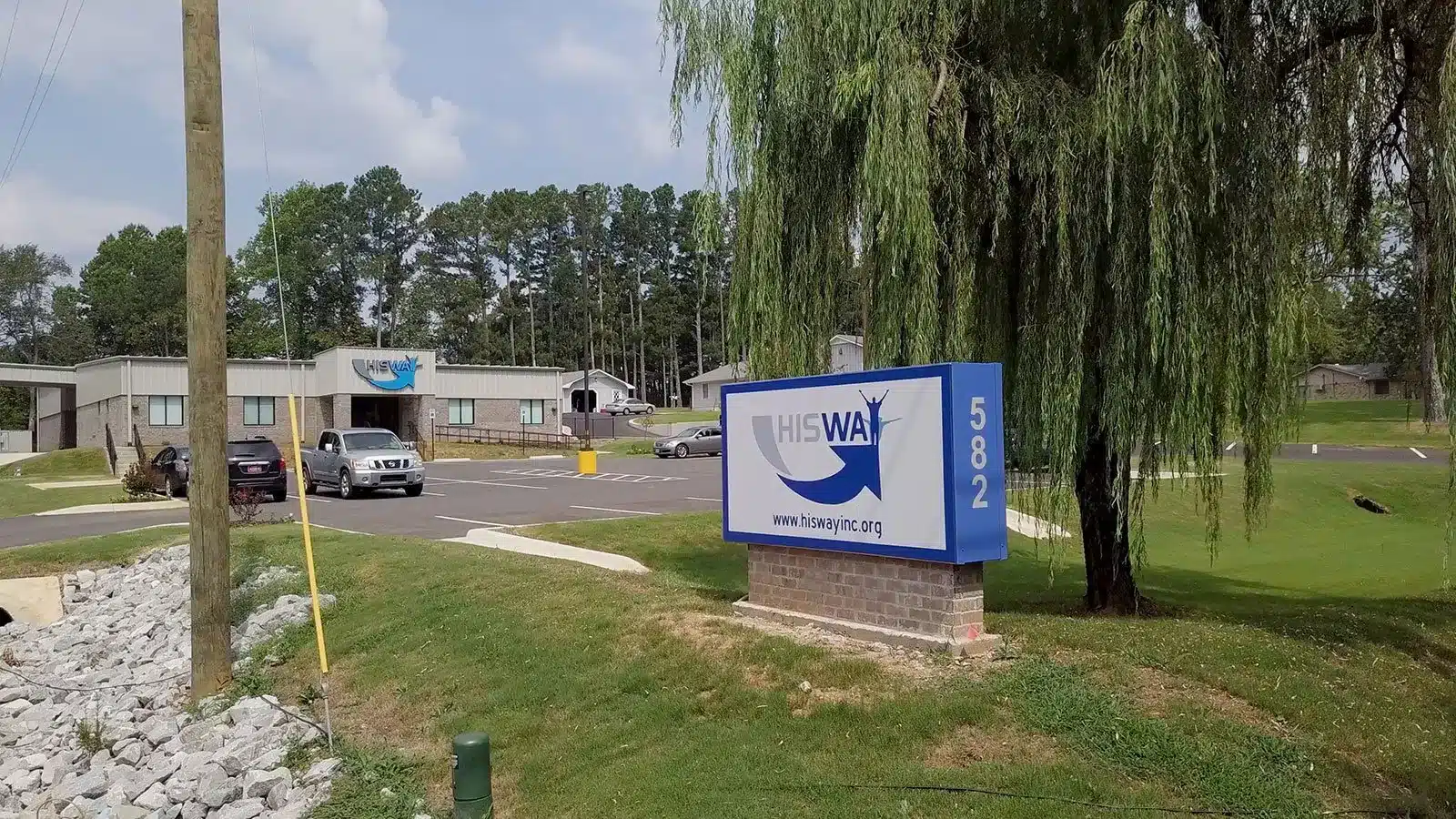
Why a Crack Inpatient Rehab Program Could Save Your Life
A crack inpatient rehab program is a live-in treatment center providing 24/7 medical supervision, therapy, and support for crack cocaine addiction. Lasting 30 to 90 days or more, these programs offer a structured path to recovery, starting with medically-supervised detox and continuing through comprehensive aftercare planning.
Key features of top crack inpatient rehab programs include:
- Medically-supervised detoxification to safely manage withdrawal.
- 24/7 monitoring in a trigger-free environment.
- Evidence-based therapies like CBT and Motivational Interviewing.
- Dual-diagnosis treatment for co-occurring mental health conditions.
- Individualized treatment plans custom to your needs.
- Holistic therapies such as yoga, meditation, and nutritional counseling.
- Aftercare and relapse prevention planning.
Crack cocaine is one of the most addictive substances known, hijacking the brain’s reward system with an intense but short-lived high. This cycle drives compulsive use. In 2021, over 24,000 Americans died from cocaine-related overdoses, a 22% increase from 2020. These numbers are sobering, but they also show that more people are recognizing the need for help.
Recovery is possible. While crack addiction feels overwhelming, thousands of people break free each year through professional treatment. Inpatient rehab offers the highest level of care, removing you from triggers and surrounding you with medical professionals and peers who understand. At Addiction Helpline America, we connect people with treatment centers that offer compassionate, evidence-based care. We created this guide to help you find an effective program.

Relevant articles related to crack inpatient rehab program:
Understanding Crack Addiction and Why Inpatient Care is Crucial
Crack cocaine use can quickly spiral into a devastating cycle that affects your health, relationships, and sense of self. Recognizing the signs and knowing when to seek professional help can be the difference between life and death.
What are the signs that someone needs inpatient crack cocaine rehab?
If you’re wondering whether you or a loved one needs help, trust your instincts. The signs often grow from small to impossible to ignore.
- Behavioral changes: Increased secrecy, lying, neglecting responsibilities, and abandoning hobbies. Drug-seeking behavior becomes the top priority, leading to financial issues and risky decisions.
- Physical symptoms: A cycle of hyperactivity followed by an extreme “crash.” Rapid weight loss, poor hygiene, dilated pupils, and a chronic cough are common. Dental issues like “crack mouth” (tooth decay and bleeding gums) can develop. Overdose symptoms like seizures or hallucinations require immediate medical attention.
- Psychological signs: Paranoia, severe depression following the high, constant anxiety, and wild mood swings. In severe cases, psychosis can occur, including hallucinations like feeling bugs crawling under the skin (“coke bugs”).
If you recognize these signs, a crack inpatient rehab program could save a life.
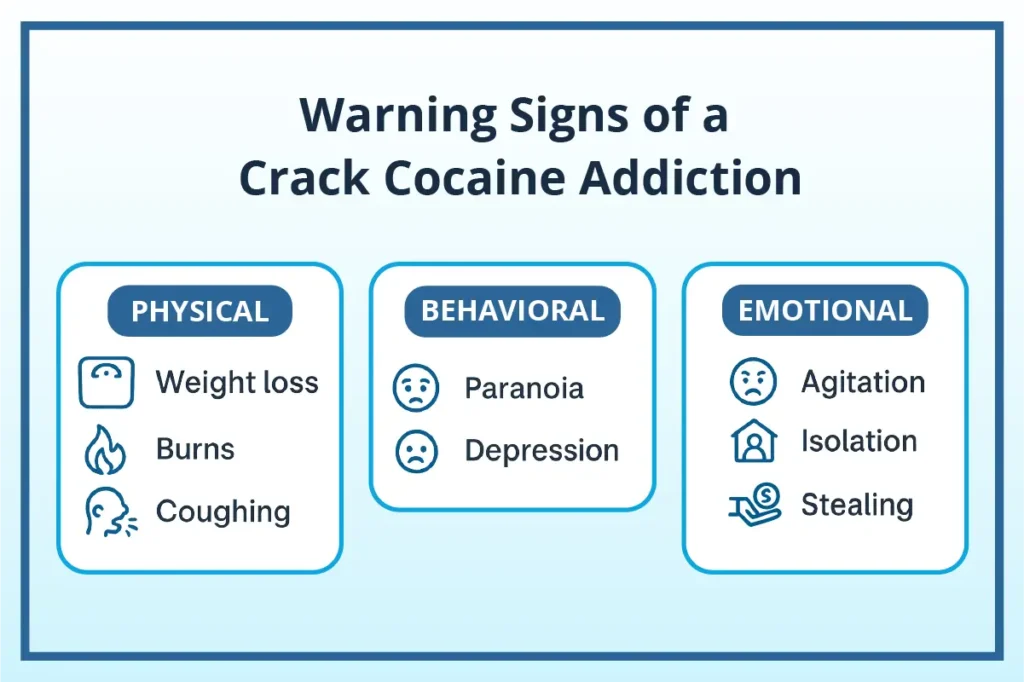
The Long-Term Health Risks of Untreated Crack Addiction
Untreated crack addiction poses severe health risks. Cardiovascular problems are among the most dangerous, as the drug constricts blood vessels and overworks the heart, increasing the risk of cardiovascular health problems like heart attacks and strokes, even in young users. Respiratory system damage from smoking leads to “crack lung,” causing persistent coughing and chest pain. Other risks include kidney damage, gastrointestinal issues, and a weakened immune system. Many of these conditions can improve with sobriety and medical care.
Why Inpatient Rehab Outweighs Outpatient Options for Crack Addiction
For crack’s powerful grip, inpatient care is typically required. 24/7 monitoring and support provides constant medical and emotional help during intense cravings and withdrawal. The structured, trigger-free environment removes you from the people and places that fuel addiction, giving your brain space to heal. Days are filled with intensive therapy and education, replacing the chaos of addiction with a schedule designed for recovery. Most importantly, inpatient programs excel at addressing co-occurring disorders like depression or PTSD, treating both the addiction and underlying mental health issues simultaneously for a stronger foundation in sobriety.
The 10 Hallmarks of a Top-Tier Crack Inpatient Rehab Program
When searching for a crack inpatient rehab program, it’s crucial to know what separates an effective program from the rest. Not all rehabs are created equal; the best centers provide a comprehensive foundation for lasting recovery.
Here’s what to look for:
1. Medically-Supervised Detox: Ensures your safety and comfort during the difficult withdrawal phase.
2. Dual-Diagnosis Capability: Treats both addiction and any co-occurring mental health disorders like depression or anxiety simultaneously.
3. Evidence-Based Therapies: Uses scientifically proven methods like Cognitive Behavioral Therapy (CBT) and Motivational Interviewing.
4. Individualized Treatment Plans: Creates a custom plan based on your unique history, needs, and goals.
5. A Structured, Safe Environment: Provides a stable, trigger-free setting that promotes healing.
6. Holistic and Complementary Treatments: Addresses the whole person with activities like yoga, art therapy, and nutritional counseling.
7. Family Program Integration: Involves loved ones in the recovery process through therapy and education to heal relationships.
8. Comprehensive Aftercare Planning: Prepares you for life after rehab with robust relapse prevention strategies and support connections.
9. Licensed, Credentialed Staff: Employs qualified doctors, certified therapists, and experienced addiction specialists.
10. Life Skills and Re-entry Training: Equips you with practical tools for sober living, such as financial management and communication skills.
Using these ten hallmarks as a checklist will help you evaluate a crack inpatient rehab program and choose a center that offers the comprehensive care needed to overcome addiction. At Addiction Helpline America, we specialize in connecting you with programs that meet these high standards and fit your unique situation.
1. Medically-Supervised Detoxification
The first step in any crack inpatient rehab program is detoxification, which should never be attempted alone. While crack withdrawal is not typically life-threatening, the psychological challenge is immense. The intense cravings and emotional crash can quickly lead to relapse without professional support.
In a medically-supervised detox, healthcare professionals monitor your health and help manage withdrawal symptoms. Psychological symptoms are often the most difficult, including the severe depression of the “crash phase,” overwhelming anxiety, paranoia, and irritability. Physical symptoms like profound fatigue, insomnia, and vivid nightmares add to the discomfort. Cravings can feel relentless and all-consuming.
To ease these symptoms, doctors may prescribe temporary medications like antidepressants to stabilize mood or anxiolytics to manage restlessness. This isn’t a cure, but a support to get you through the toughest phase safely.
The detox process generally has three phases: the initial crash phase (hours to days), the withdrawal phase (1-10 weeks) with ongoing cravings and mood swings, and the extinction phase, where cravings gradually diminish.
This is why professional detox drug detox is critical. It provides the safety, comfort, and medical oversight needed to steer withdrawal successfully, allowing the real work of recovery to begin. Attempting to detox at home, surrounded by triggers, is a recipe for relapse.

2. Integrated Dual-Diagnosis Treatment
It’s extremely common for people in a crack inpatient rehab program to find that their addiction is intertwined with an underlying mental health issue. Conditions like PTSD, depression, anxiety, and bipolar disorder often fuel substance abuse in a painful cycle: using crack to escape symptoms only makes them worse, leading to more use.
This is why integrated dual-diagnosis treatment is essential. Treating addiction while ignoring mental health—or vice versa—rarely leads to lasting recovery. An integrated approach treats both conditions simultaneously as interconnected parts of your overall health.
Treatment begins with a comprehensive psychiatric evaluation to accurately identify any co-occurring disorders. From there, a psychiatrist may use medication management to prescribe and monitor medications that stabilize mental health symptoms, such as antidepressants or mood stabilizers. This provides the mental clarity needed to engage fully in therapy.
Therapy is then specialized to address how your addiction and mental health disorder influence each other. You’ll learn healthier coping mechanisms and address root causes, such as processing past trauma in a safe environment to reduce the urge to self-medicate.
At Addiction Helpline America, we connect you with programs that provide this truly holistic care. To learn more about finding comprehensive support, explore our how to find the right rehab facility guide.
3. Evidence-Based Behavioral Therapies
Entering a crack inpatient rehab program isn’t just about stopping drug use—it’s about learning to live differently. Evidence-based behavioral therapies are scientifically proven methods that help rewire the thought patterns and behaviors that drive addiction.
- Cognitive Behavioral Therapy (CBT) helps you identify and challenge the negative thoughts that lead to using crack, replacing them with healthier coping strategies.
- Contingency Management (CM) uses positive reinforcement, offering tangible rewards for achieving sobriety milestones like clean drug tests, which is highly effective in early recovery.
- Motivational Interviewing (MI) helps you resolve ambivalence about recovery by connecting sobriety to your personal values and goals, building internal motivation.
- Dialectical Behavior Therapy (DBT) teaches crucial skills for mindfulness, distress tolerance, emotion regulation, and interpersonal effectiveness, which are invaluable for managing intense feelings without using.
Group therapy provides the power of shared experience, reducing isolation and showing you that you’re not alone. In a group, you can receive feedback from peers who truly understand your struggle. Meanwhile, individual counseling offers a confidential space to address personal issues, process trauma, and develop a recovery plan custom to your life.
Together, these therapies provide a toolkit of coping strategies, a deeper understanding of your addiction, and the confidence to build a new life without crack cocaine.
4. Comprehensive Aftercare and Relapse Prevention
Finishing a crack inpatient rehab program is the beginning of your recovery journey, not the end. The most effective programs prepare you for the rest of your life, which is why comprehensive aftercare and relapse prevention planning is non-negotiable.
Discharge planning should begin early in your stay, creating a personalized roadmap for life after treatment. This plan addresses your living situation, support system, and specific triggers.
For many, transitioning to a sober living home is a crucial next step. These residences offer a drug-free environment with accountability and peer support, acting as a bridge between 24/7 care and full independence. Our guide on how to choose sober living can help you find the right fit.
Support groups like Narcotics Anonymous and Cocaine Anonymous are the backbone of long-term recovery for many. They offer a free, accessible community of people who share their experience, strength, and hope without judgment.
Many rehabs also have alumni programs to keep you connected to a recovery community through check-ins and events. Finally, ongoing therapy—whether individual or group—is vital for applying what you learned in rehab to real-world challenges.
Aftercare isn’t a sign of weakness; it’s a sign of wisdom. It acknowledges that recovery is an active, ongoing process. At Addiction Helpline America, we connect you with programs that provide this long-term support, because that’s when the real rewards of recovery begin.
A Day in the Life: What to Expect During Treatment
When you enter a crack inpatient rehab program, you step into a structured world designed entirely for your recovery. This routine provides a sense of safety and purpose when everything else feels uncertain.

What does a typical day look like in an inpatient crack cocaine rehab program?
Days typically start early with a nutritious breakfast and a morning meditation or check-in to center yourself. The core of the day is dedicated to therapy, including individual counseling, group sessions, and educational workshops. You’ll work on identifying triggers, reshaping thought patterns, and understanding the science of addiction.
Afternoons often include life skills training (e.g., financial management, job readiness) and specialized workshops. Recreational activities like art therapy, music, or outdoor exercise are also woven in to help you refind joy without substances. Evenings may involve support group meetings or time for personal reflection before a scheduled lights-out, ensuring your body gets the rest it needs to heal.
How long does an inpatient crack cocaine rehab program typically last?
The right length of stay depends on addiction severity, co-occurring conditions, and personal progress. Before the program begins, medical detoxification typically lasts a few days to a week.
- 30-day programs provide an intensive foundation, covering detox and initial therapy. They are best for those with shorter addiction histories and strong home support.
- 60-day programs allow for deeper therapeutic work. The extra time helps solidify new behaviors and is often when major breakthroughs occur. Our guide to the best 60 day rehabs near me can help you explore options.
- 90-day programs are often recommended for crack addiction. Research shows longer treatment correlates with better long-term outcomes, giving your brain chemistry more time to normalize.
- Longer-term options (6+ months) are available for those with multiple relapses or complex disorders, offering a gradual transition back to independent living.
The goal is not to rush treatment, but to give yourself enough time to truly heal. We can help you find a program with the right duration for your needs.
Navigating the Logistics: Cost, Insurance, and Program Length
Thinking about the cost of treatment can be daunting, but recovery is an investment in your life, and many payment options are available. The cost of a crack inpatient rehab program varies based on location, amenities, and length of stay.
| Program Length | Estimated Cost (Without Insurance) | Estimated Cost (With Insurance) |
|---|---|---|
| 30-Day | $10,000 – $30,000 | Varies (often lower out-of-pocket) |
| 60-Day | $20,000 – $60,000 | Varies (often lower out-of-pocket) |
| 90-Day | $30,000 – $90,000+ | Varies (often lower out-of-pocket) |
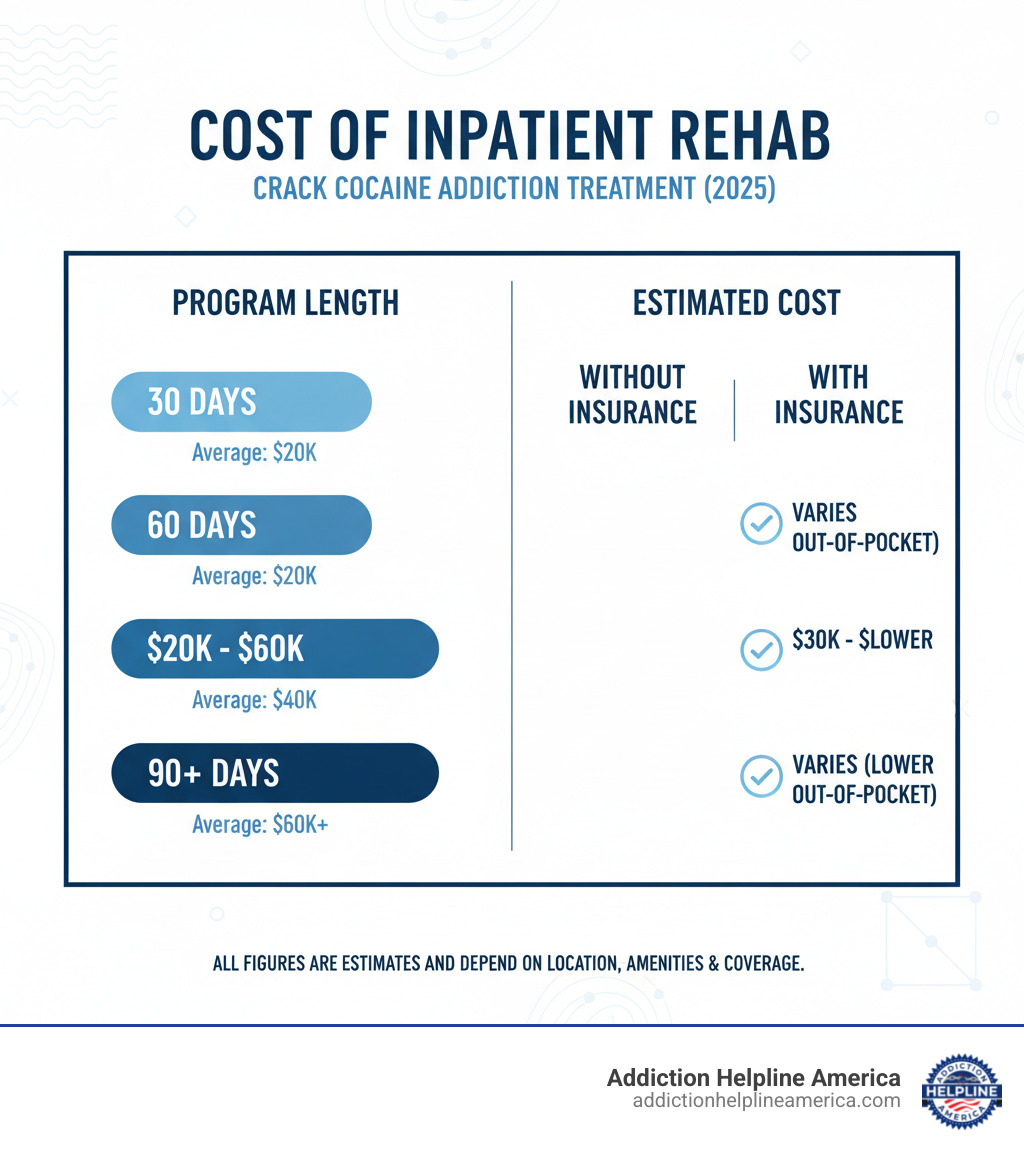
If you have insurance, most private plans (like BCBS, Aetna, Cigna) cover a portion of addiction treatment. We can help you verify your benefits to understand your out-of-pocket costs. If you don’t have insurance, don’t give up. Options include:
- Financing options or payment plans offered by facilities.
- Sliding scale fees based on your income.
- State-funded programs that offer low-cost or free treatment, often through Medicaid.
We can help you find affordable drug rehab options that work for you.
The ideal program length is determined with treatment professionals based on factors like the severity of addiction, the presence of co-occurring mental health disorders, your personal history with relapse, and your support system at home. While 30 days is a strong start, experts often recommend at least 60 to 90 days for crack addiction to build a solid foundation for recovery.
Frequently Asked Questions about Crack Inpatient Rehab Programs
Considering a crack inpatient rehab program brings up many questions. We’ve answered some of the most common ones to provide clarity and ease your concerns.
What is the success rate for crack cocaine rehab?
Defining “success” in recovery is personal. For some, it’s lifelong abstinence; for others, it’s a drastically improved quality of life, repaired relationships, and stable employment. Abstinence rates vary, but outcomes are significantly better for those who complete a full treatment program and engage in aftercare.
Relapse does not equal failure. It can be a part of the recovery journey. What matters is learning from the experience and getting back on track. Long-term recovery is a process influenced by completing treatment, connecting with support groups like Narcotics Anonymous, addressing mental health, and building a sober network.
Are there medications to treat crack cocaine addiction?
Currently, there are no FDA-approved medications specifically to treat crack cocaine addiction itself, unlike treatments for opioids or alcohol. This makes behavioral therapies the cornerstone of recovery.
However, medications play a vital supporting role. During detox and early recovery, doctors may prescribe:
- Antidepressants for the severe depression that follows cessation of use.
- Anxiolytics (anti-anxiety medications) to ease restlessness and anxiety.
- Sleep aids to manage insomnia.
These medications help manage withdrawal symptoms and co-occurring conditions, making it possible to focus on therapy. For more information on cocaine, visit the National Institute on Drug Abuse: What is cocaine?
How does a crack inpatient rehab program address co-occurring disorders?
Addiction rarely exists in a vacuum. Many people also struggle with PTSD, depression, or anxiety. A quality crack inpatient rehab program provides integrated dual-diagnosis treatment, addressing both addiction and mental health disorders simultaneously.
This process begins with a comprehensive psychiatric evaluation to identify any underlying conditions. A coordinated team then develops a treatment plan that may include medication management to stabilize mental health symptoms and specialized therapy to address how the conditions influence each other. Treating both issues at the same time is essential for breaking the cycle of self-medication and relapse. If you’re looking for this type of integrated care, our guide on drug rehab for professionals may offer helpful insights.
Finding Hope and Healing on the Path to Recovery
If you’re reading this, you’ve taken the brave first step of seeking information. Whether for yourself or a loved one, know that recovery is possible, and you don’t have to do it alone.
The path from crack cocaine addiction is challenging but rewarding. A crack inpatient rehab program provides the strongest foundation for sobriety through medically supervised detox, intensive therapies, dual-diagnosis care, and robust aftercare planning. Thousands of people break free from crack addiction every year, rebuilding their health, relationships, and futures.
Choosing the right program is critical. A top-tier facility treats the whole person, equipping you with the tools to steer life without returning to crack cocaine. This is an investment in your future, your peace of mind, and your well-being.

At Addiction Helpline America, our mission is to connect you with the right addiction and mental health treatment. We offer free, confidential, and personalized guidance, using our nationwide network of trusted programs to find a facility that fits your unique needs. Your story matters, and your path to recovery should be custom to you.
Taking the next step is courageous. Let us help you explore your options and find a crack inpatient rehab program that offers the compassionate, evidence-based care you deserve. Your future is waiting.
To explore different treatment options, we invite you to visit our comprehensive guide: Find the right types of treatment programs for you.
Recovery isn’t just about stopping drug use. It’s about reclaiming your life.
Our helpline is 100%
free & confidential
If you or someone you care about is struggling with drug or alcohol addiction, we can help you explore your recovery options. Don’t face this challenge alone—seek support from us.
Programs
Resources
Will my insurance
cover addiction
treatment?
We're ready to help
Find the best
drug or alcohol treatment
center
Are you or a loved one struggling with addiction? Call today to speak to a treatment expert.



